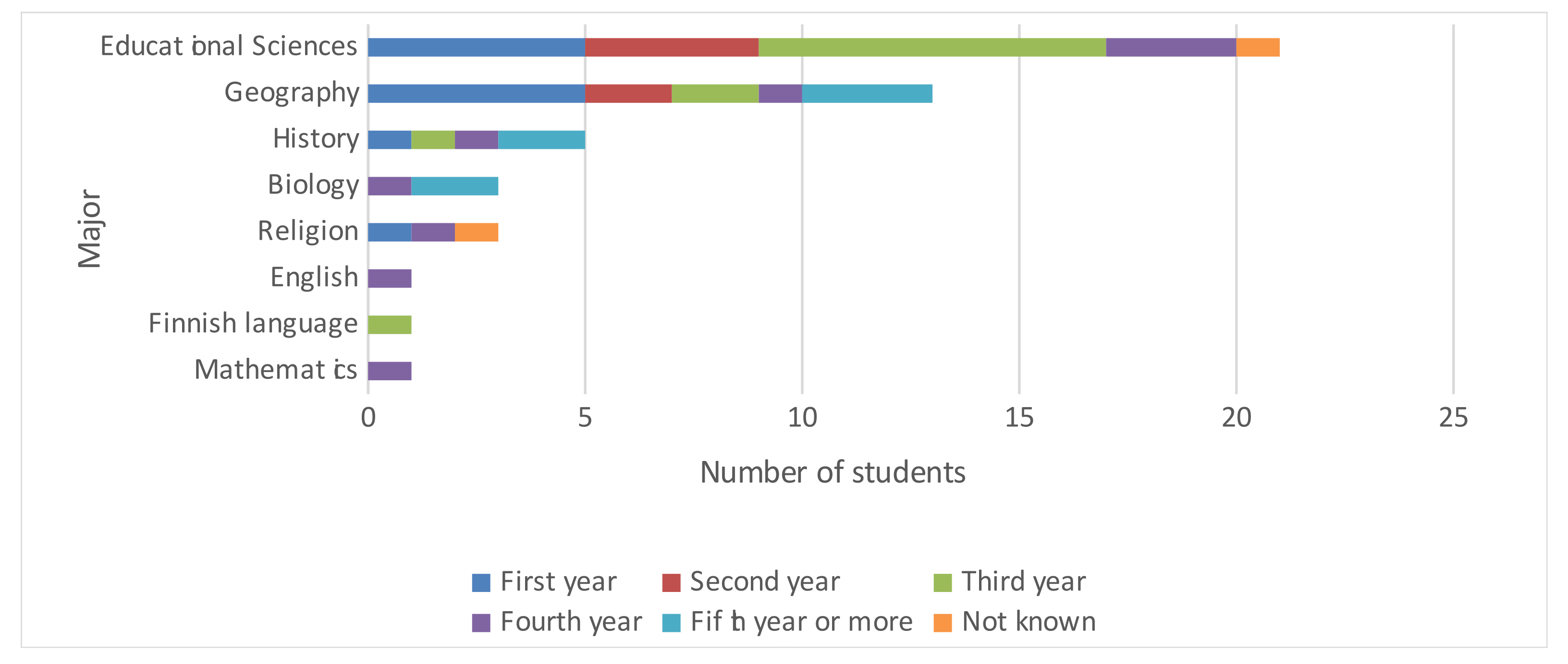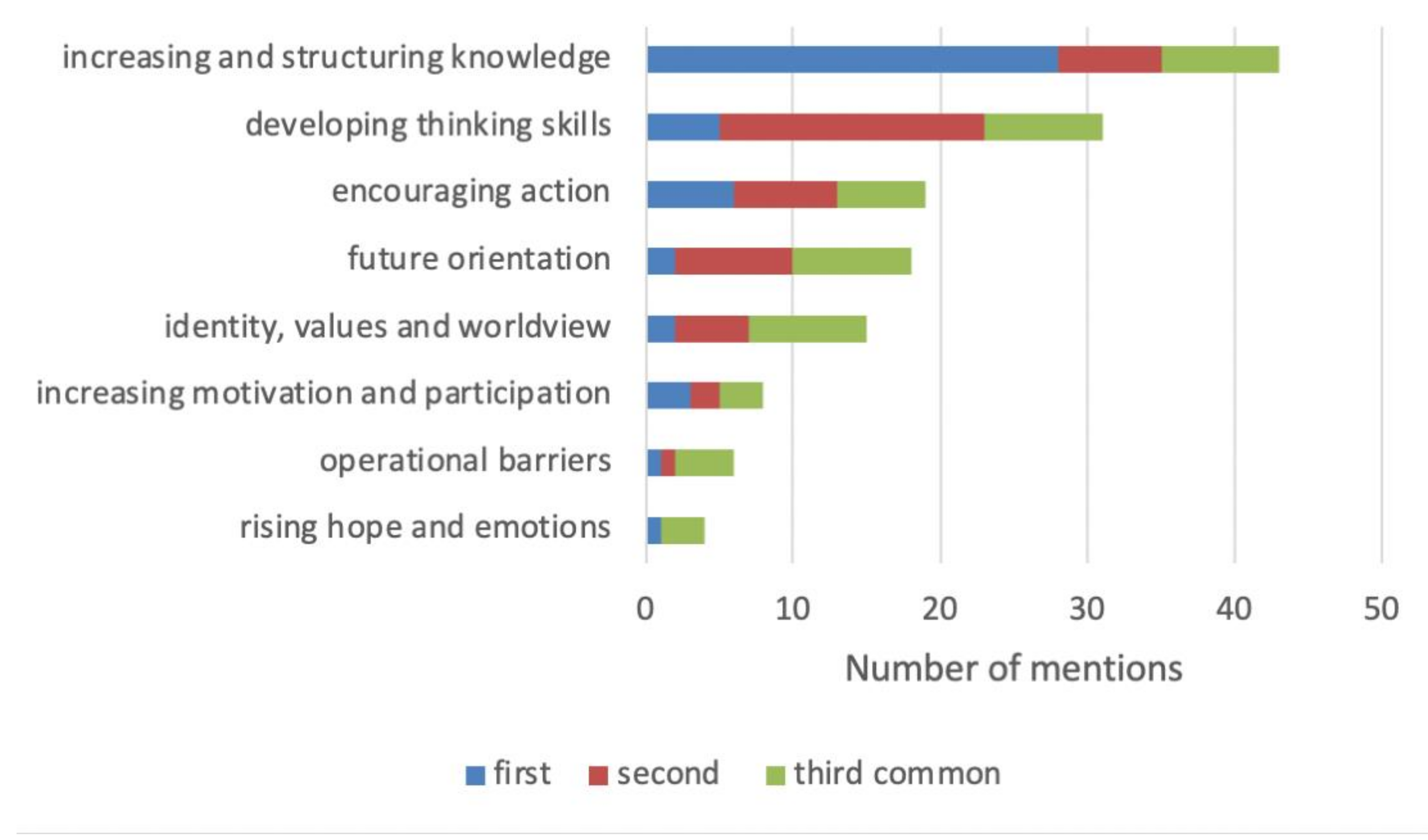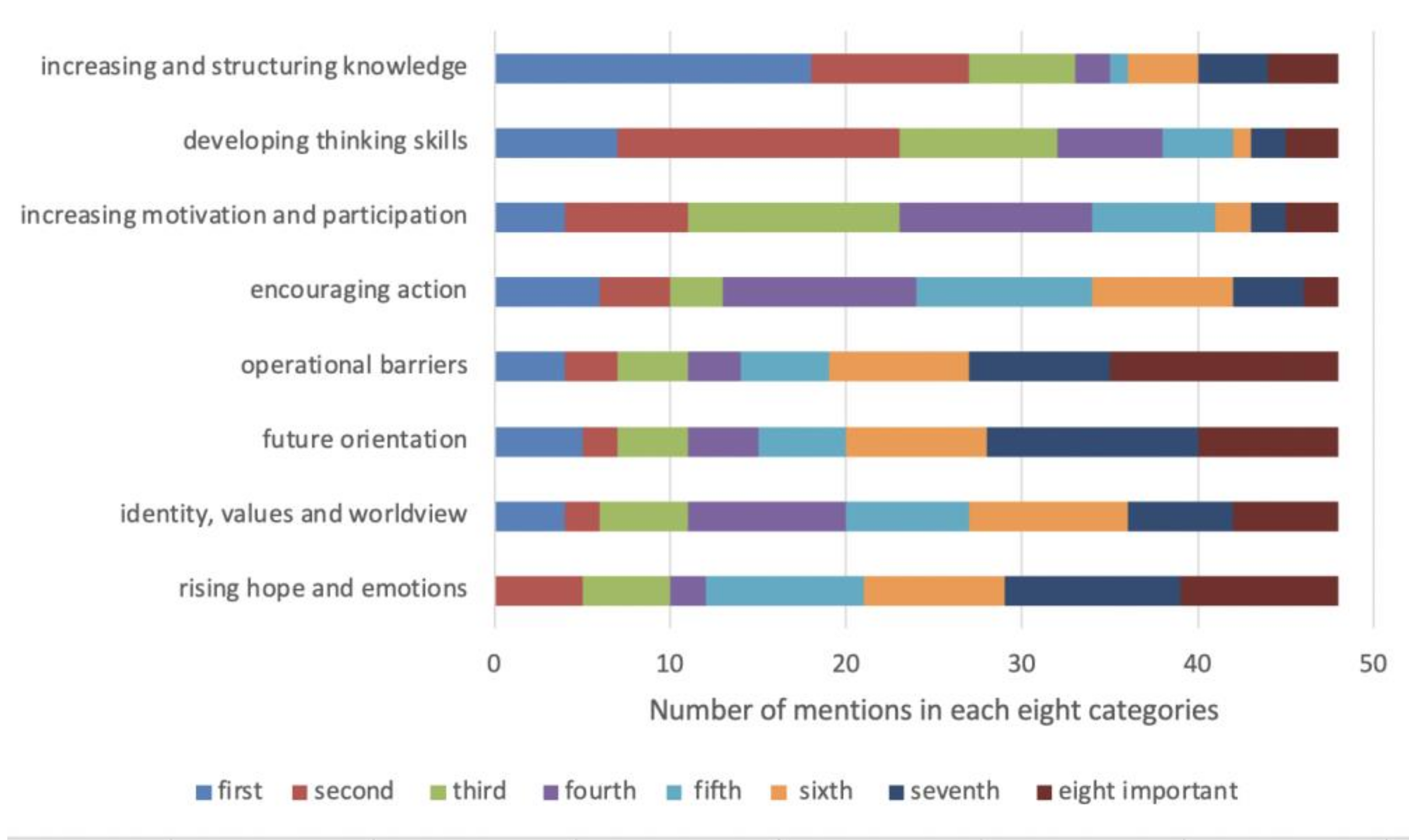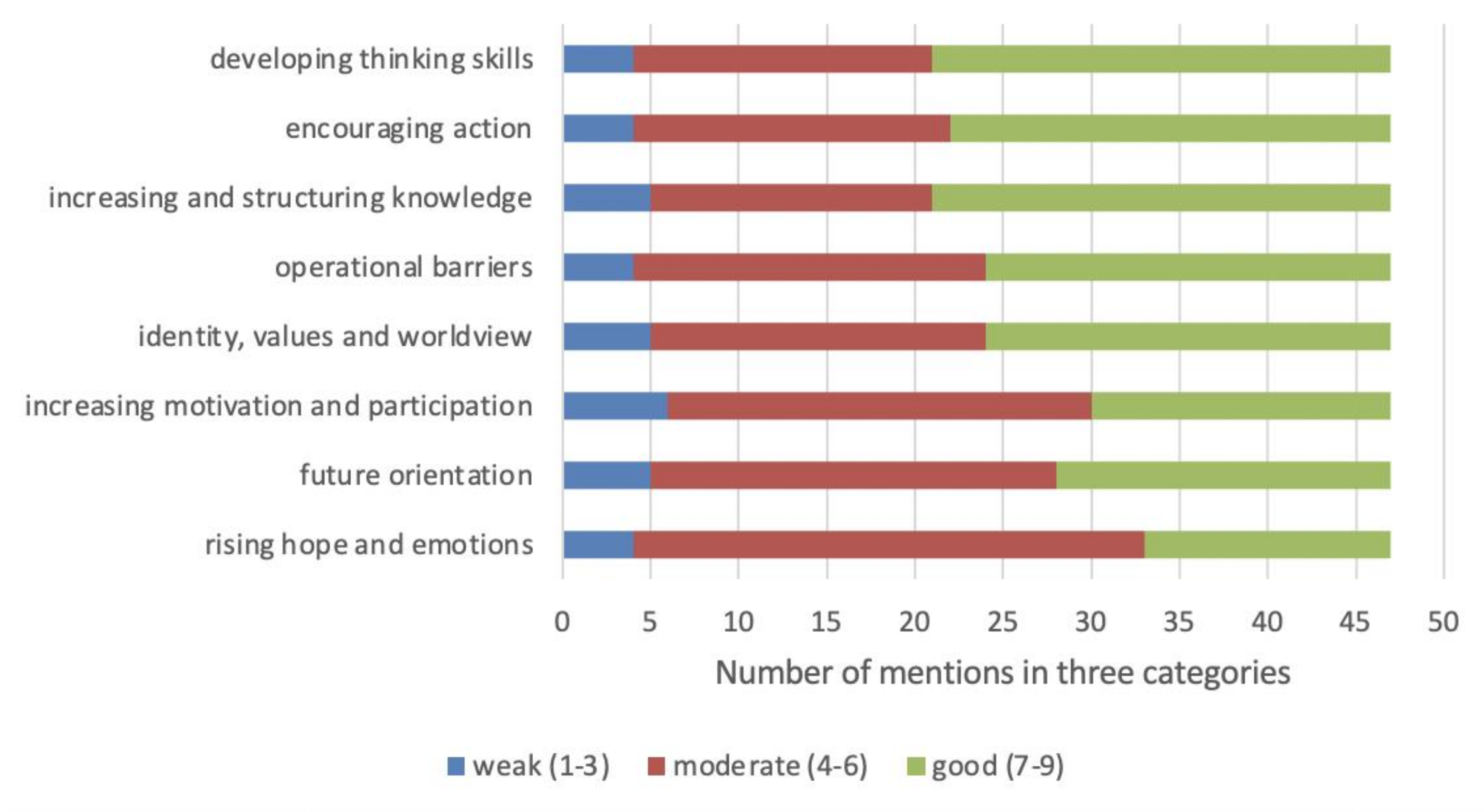Finnish University Students’ Views on Climate Change Education and Their Own Ability to Act as Climate Educators
Abstract
:1. Introduction
- What kinds of views do Finnish university students have about the current state of upper secondary school CCE?
- What kinds of views do Finnish university students have about the future aspects of upper secondary school CCE?
- How do Finnish university students view their own abilities to promote CCE?
2. Theoretical Background
2.1. Specific Features of Climate Change Education (CCE)
2.2. Challenges of Climate Change Education (CCE)
2.3. Climate Change (CC) in Finnish Upper Secondary Education
3. Study Design and Methods
3.1. Participants and Settings
3.2. Measures
3.3. Analyses
3.4. Judging the Methodology
4. Results
4.1. Respondents’ Views on the Current State of Upper Secondary School Climate Change Education (CCE) in Finland
‘... more “thinking about the future”, e.g., what kinds of companies will there be in the future, what kinds of business ideas will become more common and be successful in the future, e.g., sharing and lending culture, rental of services, etc.’ (Respondent 17, age group: 24–28)
4.2. Respondents’ Views of Future Upper Secondary Education Related to Climate Change (CC)
“Teaching should be multidisciplinary: taking place both in social sciences and in visual art studies”. (Respondent 42, age group: 19–23 years)
“More systematic, through integrating subjects, not focusing on studies of geography and biology only”. (Respondent 29, age group: 29–33 years)
“Focusing on climate issues at the political level, e.g., in social sciences. Knowledge of, for example, barriers to applying flight taxes can tutor you for studies in the university”. (Respondent 14, age group: 24–28 years)
“Group discussions and sharing your own experiences. The teacher can make use of your comments and thoughts, adding them in their teaching”. (Respondent 28, age group: 19–23 years)
“You tell… more about, e.g., vegetarian food and proteins of vegan origin… You share… in your health education classes… vegetarian food recipes easy and fast to make”. (Respondent 25, age group: 19–23 years)
“… more practical advice to the students on how they themselves can influence … you need to remind them that small deeds matter...”. (Respondent 10, age group: 19–23 years)
“It would be fine, if… you could offer knowledge… concretely through various projects. You should... really put effort into these ones and they should be made long-lasting vehicles modifying/changing one’s thinking”. (Respondent 8, age group: 19–23 years)
4.3. Respondents’ Views of Their Own Capacity to Address Climate Change (CC) Issues
5. Discussion
6. Conclusions and Implications
Author Contributions
Funding
Informed Consent Statement
Data Availability Statement
Conflicts of Interest
References
- IPCC (Intergovernmental Panel on Climate Change). Contribution of working group II to the fifth assessment report of the intergovernmental panel on climate change. In AR5 Climate Change: Impacts, Adaptation, and Vulnerability. 2014. Available online: http://www.ipcc.ch/report/ar5/wg2/ (accessed on 19 April 2021).
- Flora, J.A.; Saphir, M.; Lappé, M.; Roser-Renouf, C.; Maibach, E.W.; Leiserowitz, A.A. Evaluation of a national high school entertainment education program: The Alliance for Climate Education. Clim. Chang 2014, 127, 419–434. [Google Scholar] [CrossRef] [Green Version]
- Myllyniemi, S. (Ed.) Environment. In Nuorisobarometri: Valtion Nuorisoneuvoston Julkaisuja 56; Grano: Helsinki, Finland, 2017. [Google Scholar]
- Budziszewska, M.; Głód, Z. “These Are the Very Small Things That Lead Us to That Goal”: Youth Climate Strike Organizers Talk about Activism Empowering and Taxing Experiences. Sustainability 2021, 13, 11119. [Google Scholar] [CrossRef]
- MacKay, M.; Parlee, B.; Karsgaard, G. Youth Engagement in Climate Change Action: Case Study on Indigenous Youth at COP24. Sustainability 2020, 12, 6299. [Google Scholar] [CrossRef]
- Dufty, N. A new approach to disaster education. In Proceedings of the International Emergency Management Society (TIEMS) Annual Conference, Manila, Philippines, 13–16 November 2018; Available online: https://www.academia.edu/37825155/A_new_approach_to_disaster_education?email_work_card=view-paper (accessed on 19 April 2021).
- Rinne, R.; Kivirauma, J.; Lehtinen, E. Johdatus Kasvatustieteisiin; PS-kustannus: Jyväskylä, Finland, 2015; ISBN 978-952-451-634-1. [Google Scholar]
- Anderson, A. Climate change education for mitigation and adaptation. J. Educ. Sustain. Dev. 2012, 6, 191–206. [Google Scholar] [CrossRef]
- Lehtonen, A.; Cantell, H.; Ilmastokasvatus Osaamisen ja Vastuullisen Kansalaisuuden Perustana. Suomen Ilmastopaneelin Raportti, 1. 2015. Available online: https://www.ilmastopaneeli.fi/wp-content/uploads/2018/10/Ilmastokasvatuksen-raportti-9.6.2015.pdf (accessed on 19 April 2021).
- Ratinen, I.; Kinni, A.; Muotka, A.; Sarivaara, E. Kohti Ratkaisukeskeistä Ilmastokasvatusta. Suomen Ilmastopaneelin Raportti. 2019. Available online: https://www.ilmastopaneeli.fi/wp-content/uploads/2019/11/Ilmastokasvatusraportti_final.pdf (accessed on 20 November 2021).
- Tolppanen, S.; Aarnio-Linnanvuori, E.; Cantell, H.; Lehtonen, A. Pirullisen ongelman äärellä: Kokonaisvaltaisen ilmastokasvatuksen malli. Kasvatus 2017, 5, 456–468. [Google Scholar]
- Merriam-Webster. Dictionary. 2022. Available online: https://www.merriam-webster.com/dictionary (accessed on 19 April 2021).
- Graff, H. The ‘Problem’ of Interdisciplinarity in Theory, Practice, and History. Soc. Sci. Hist. 2016, 40, 775–803. [Google Scholar] [CrossRef]
- Finnish National Agency for Education. National Core Curriculum for Basic Education; Finnish National Agency for Education: Helsinki, Finland, 2014. [Google Scholar]
- Finnish National Agency for Education. National Core Curriculum for General Upper Secondary Schools; Finnish National Agency for Education: Helsinki, Finland, 2015. [Google Scholar]
- Finnish National Agency for Education. National Core Curriculum for General Upper Secondary Schools; Finnish National Agency for Education: Helsinki, Finland, 2019. [Google Scholar]
- Teachers Climate Guide. Geography. Available online: https://teachers-climate-guide.fi/geography/ (accessed on 19 April 2021).
- Leiserowitz, A.; Smith, N.; Marlon, J.R. American Teens’ Knowledge of Climate change. In Proceedings of the Yale Project on Climate Change Communication; Yale University: New Haven, CT, USA, 2011; Available online: http://www.ourenergypolicy.org/wp-content/uploads/2013/05/American-Teens-Knowledge-of-Climate-Change.pdf (accessed on 19 April 2021).
- Shepardson, D.P.; Niyogi, D.; Choi, S.; Charusombat, U. Seventh grade students’ conceptions of global warming and climate change. Environ. Educ. Res. 2009, 15, 549–570. [Google Scholar] [CrossRef]
- Taber, F.; Taylor, N. Climate of concern: A search for effective strategies for teaching children about global warming. Int. J. Environ. Sci. Educ. 2009, 4, 97–116. [Google Scholar]
- Chen, X. Why do people misunderstand climate change? Heuristics, mental models and ontological assumptions. Clim. Chang. 2011, 108, 31–46. [Google Scholar] [CrossRef]
- Choi, S.; Niyogi, D.; Shepardson, D.P.; Charusombat, U. Do earth and environmental science textbooks promote middle and high school students’ conceptual development about climate change? Textbooks’ consideration of students’ misconceptions. Bull. Am. Meteorol. Soc. 2010, 91, 889–898. [Google Scholar] [CrossRef] [Green Version]
- Ratinen, I. Primary student teachers’ climate change conceptualization and implementation on inquiry-based and communicative science teaching: A design research. In Jyvaäskylaä Studies in Education, Psychology and Social Research; University of Jyväskylä: Jyväskylä, Finland, 2016; p. 555. [Google Scholar]
- Sterman, J.D. Communicating climate change risks in a skeptical world. Clim. Chang. 2011, 108, 811. [Google Scholar] [CrossRef] [Green Version]
- Bråten, I.; Britt, M.A.; Strømsø, H.I.; Rouet, J.-F. The role of epistemic beliefs in the comprehension of multiple expository texts: Toward an integrated model. Educ. Psychol. 2011, 46, 48–70. [Google Scholar] [CrossRef]
- Lehtonen, A.; Salonen, A.O.; Cantell, H. Climate change education: A new approach for a world of wicked problems. In Sustainability, Human Well-being, and the Future of Education; Cook, J.W., Ed.; Palgrave Macmillian: London, UK, 2018; pp. 339–374. ISBN 978-331-978-579-0. [Google Scholar] [CrossRef] [Green Version]
- Tani, S.; Hilander, M.; Leivo, J. Ilmastonmuutos lukion opetussuunnitelmissa ja maantieteen oppikirjoissa. Ainedidaktiikka 2020, 4, 3–24. [Google Scholar] [CrossRef]
- Brouziyne, Y.; Abouabdillah, A.; Hirich, A.; Bouabid, R.; Zaaboul, R.; Benaabidate, L. Modeling sustainable adaptation strategies toward a climate-smart agriculture in a Mediterranean watershed under projected climate change scenarios. Agric. Syst. 2018, 162, 154–163. [Google Scholar] [CrossRef]
- Jeong, J.S.; González-Goómez, D.; Cañada-Cañada, F. Prioritizing elements of science education for sustainable development with the MCDA-DEMATEL method using the flipped e-learning scheme. Sustainability 2019, 11, 3079. [Google Scholar] [CrossRef] [Green Version]
- Jeronen, E. Sustainable Education. In Encyclopedia of Sustainable Management; Idowu, S., Schmidpeter, R., Capaldi, N., Zu, L., Del Baldo, M., Abreu, R., Eds.; Springer: Cham, Switzerland, 2022. [Google Scholar] [CrossRef]
- Sterling, S. Sustainable education—Towards a deep learning response to unsustainability. In Policy & Practice. A Development Education Review; Spring: Belfast, UK, 2008; pp. 63–68. [Google Scholar]
- Prabakaran, M. Historical appropriation of epistemological values: A goal ahead for higher education. High. Educ. Future 2020, 7, 67–81. [Google Scholar] [CrossRef] [Green Version]
- Abduganiev, O.I.; Abdurakhmanov, G.Z. Ecological education for the purposes sustainable development. Am. J. Soc. Sci. Educ. Innov. 2020, 2, 280–284. [Google Scholar] [CrossRef]
- Moore, J. Is Higher Education Ready for Transformative Learning? A Question Explored in the Study of Sustainability. J. Transform. Educ. 2005, 3, 76–91. [Google Scholar] [CrossRef]
- UNESCO (United Nations Educational, Scientific and Cultural Organization). Education for Sustainable Development. A Roadmap. #ESDfor 2030. Paris, France. 2020. Available online: https://www.gcedclearinghouse.org/sites/default/files/resources/200782eng.pdf (accessed on 20 July 2021).
- UNFCCC. United Nations Framework Convention on Climate Change. 1992. Available online: https://unfccc.int/resource/docs/convkp/conveng.pdf (accessed on 20 November 2021).
- UNESCO (United Nations Educational, Scientific and Cultural Organization). Education for Sustainable Development and Climate Change. Policy Dialogue 4. 2009. Available online: http://unesdoc.unesco.org/images/0017/001791/179122e.pdf (accessed on 20 November 2021).
- UNESCO (United Nations Educational, Scientific and Cultural Organization). The UNESCO Climate Change Initiative: Climate Change Education for Sustainable Development. Paris: UNESCO. 2010. Available online: https://unesdoc.unesco.org/images/0019/001901/190101E.pdf (accessed on 20 November 2021).
- UNESCO (United Nations Educational, Scientific and Cultural Organization); UNFCCC (United Nations Framework Convention on Climate Change). Action for Climate Empowerment: Guidelines for Accelerating Solutions Through Education, Training and Public. Paris: UNESCO and UNFCCC. 2016. Available online: https://unfccc.int/sites/default/files/action_for_climate_empowerment_guidelines.pdf (accessed on 20 November 2021).
- Hindley, A.; Wall, T. A unifying, boundary crossing approach to developing climate literacy. In Implementing Sustainability in the Curriculum of Universities: Teaching Approaches, Methods, Examples and Case Studies; Leal Filho, W., Ed.; Springer: London, UK, 2017; pp. 263–278. ISBN 978-331-970-280-3. [Google Scholar]
- Monroe, M.; Plate, R.R.; Oxarart, A.; Bowers, A.; Chaves, W.A. Identifying effective climate change education strategies: A systematic review of the research. Environ. Educ. Res. 2017, 25, 791–812. [Google Scholar] [CrossRef]
- Kagawa, F.; Selby, K. (Eds.) Education and Climate Change: Living and Learning in Interesting Times; Routledge: New York, NY, USA, 2010; ISBN 978-041-564-915-5. [Google Scholar]
- Lewis, E.; Mansfield, C.; Baudains, C. Ten tonne plan: Education for sustainability from a whole systems thinking perspective. Appl. Environ. Educ. Commun. 2014, 13, 128–141. [Google Scholar] [CrossRef]
- Draper, F. A proposed sequence for developing system thinking in a grades 4–12 curriculum. Syst. Dyn. Rev. 1993, 9, 207–214. [Google Scholar] [CrossRef]
- Salonen, A.O.; Bardy, M. Ekososiaalinen sivistys herättää luottamusta tulevaisuuteen. Aikuiskasvatus 2015, 35, 4–15. [Google Scholar] [CrossRef]
- Dragoni, L.; Oh, I.-S.; Vankatwyk, P.; Tesluk, P.E. Developing executive leader: The relative contribution of cognitive ability, personality, and the accumulation of work experience in predicting strategic thinking competency. Pers. Psychol. 2011, 64, 829–864. [Google Scholar] [CrossRef]
- Macy, J. Working through environmental despair. In Ecopsychology: Restoring the Earth, Healing the Mind; Roszak, T., Gomes, M.E., Kanner, A.D., Eds.; Sierra Club: San Francisco, CA, USA, 1995; pp. 240–269. ISBN 087-156-406-8. [Google Scholar]
- Norgaard, K.M. Living in Denial: Climate Change, Emotions, and Everyday Life; MIT Press: Cambridge, MA, USA, 2011; ISBN 978-026-201-544-8. [Google Scholar]
- Pihkala, P. Climate Anxiety; MIELI Mental Health: Helsinki, Finland, 2019. [Google Scholar]
- Stoknes, P.E. What We Think about When We Try Not to Think about Global Warming: Toward a New Psychology of Climate Action; Chelsea Green Publishing: London, UK, 2015; ISBN 978-160-358-583-5. [Google Scholar]
- Jeronen, E.; Jeronen, J.; Raustia, H. Environmental education in Finland—A case study of environmental education in nature schools. Int. J. Environ. Sci. Educ. 2009, 4, 1–23. [Google Scholar]
- Schreiner, C.; Henriksen, E.K.; Kirkeby Hansen, P.J. Climate education: Empowering today’s youth to meet tomorrow’s challenges. Stud. Sci. Educ. 2008, 41, 3–49. [Google Scholar] [CrossRef]
- Stevenson, R.B.; Nicholls, J.; Whitehouse, H. What is climate change education? Curric. Perspect. 2017, 37, 67–71. [Google Scholar] [CrossRef]
- Saloranta, S. The importance of a school’s culture in implementing Education for Sustainable Development in Basic Education grades 1–6 schools. In Studies in Education, 14; Faculty of Educational Sciences, University of Helsinki: Helsinki, Finland, 2017; (In Finnish, Abstract in English). [Google Scholar]
- Tabi, A. Does pro-environmental behaviour affect carbon emissions? Energy Policy 2013, 63, 972–981. [Google Scholar] [CrossRef]
- Wei, J.; Chen, H.; Long, R. Is ecological personality always consistent with low-carbon behavioral intention of urban residents? Energy Policy 2016, 98, 343–352. [Google Scholar] [CrossRef]
- Paco, A.; Lavrador, T. Environmental knowledge and attitudes and behaviours towards energy consumption. J. Environ. Manag. 2017, 197, 384–392. [Google Scholar] [CrossRef]
- Jakučionytė-Skodienė, M.; Liobikienė, G. The Changes in Climate Change Concern, Responsibility Assumption and Impact on Climate-friendly Behaviour in EU from the Paris Agreement Until 2019. Environ. Manag. 2022, 69, 1–16. [Google Scholar] [CrossRef] [PubMed]
- Boon, H. Pre-service teachers and climate change: A stalemate? Aust. J. Teach. Educ. 2016, 41, 39–63. [Google Scholar] [CrossRef] [Green Version]
- Lombardi, D.; Sinatra, G.M. Emotions about teaching about human-induced climate change. Int. J. Sci. Educ. 2012, 35, 167–191. [Google Scholar] [CrossRef]
- Monroe, M.C.; Oxarart, A.; Plate, R.R. A role for environmental education in climate change for secondary science educators. Appl. Environ. Educ. Commun. 2013, 12, 4–18. [Google Scholar] [CrossRef]
- Robinson, Z. Teaching climate change in higher education: Barriers and opportunities. In Pedagogy of Climate Change: An Introduction; Haslett, S., France, D., Gedye, S., Eds.; Higher Education Academy: York, UK, 2011; pp. 36–50. ISBN 978-184-102-273-4. [Google Scholar]
- Nganga, L.; Roberts, A.; Kambutu, J.; James, J. Examining pre-service teachers’ preparedness and perceptions about teaching controversial issues in social studies. J. Soc. Stud. Res. 2020, 44, 77–90. [Google Scholar] [CrossRef]
- Chang, C.-H.; Pascua, L. Singapore students’ misconceptions of climate change. Int. Res. Geogr. Environ. Educ. 2016, 25, 84–96. [Google Scholar] [CrossRef]
- Ratinen, I.; Uusiautti, S. Finnish students’ knowledge of climate change mitigation and its connection to hope. Sustainability 2020, 12, 2181. [Google Scholar] [CrossRef] [Green Version]
- Yli-Panula, E.; Laakkonen, E.; Vauras, M. High-school students’ topic-specific epistemic beliefs about climate change: An assessment-related study. Educ. Sci. 2021, 11, 440. [Google Scholar] [CrossRef]
- Leiserowitz, A.; Maibach, E.; Roser-Renouf, C.; Smith, N. Climate change in the American mind: Americans’ global warming beliefs and attitudes. In Yale Project on Climate Change Communication; Yale University and George Mason University: New Haven, CT, USA, 2010. [Google Scholar]
- Poortinga, W.; Spence, A.; Whitmarsh, L.; Capstick, S.; Pidgeon, N.F. Uncertain climate: An investigation into public scepticism about anthropogenic climate change. Glob. Environ. Chang. 2011, 21, 1015–1024. [Google Scholar] [CrossRef]
- Cano, F. Epistemological beliefs and approaches to learning: Their change through secondary school and their influence on academic performance. Br. J. Educ. Psych. 2005, 75, 203–221. [Google Scholar] [CrossRef]
- Mason, L.P.; Boscolo, M.; Tornatora, C.; Ronconi, L. Besides knowledge: A cross-sectional study on the relations between epistemic beliefs, achievement goals, self-beliefs and achievement in science. Instr. Sci. 2013, 41, 49–79. [Google Scholar] [CrossRef]
- Cantell, H.; Tolppanen, S.; Aarnio-Linnanvuori, E.; Lehtonen, A. Bicycle model on climate change education: Presenting and evaluating a model. Environ. Educ. Res. 2019, 25, 717–731. [Google Scholar] [CrossRef]
- Reid, A. Climate change education and research: Possibilities and potentials versus problems and perils? Environ. Educ. Res. 2019, 25, 767–790. [Google Scholar] [CrossRef] [Green Version]
- Finnish National Agency for Education. National Core Curriculum for Basic Education for adults. In Regulations and Quidelines; PunaMusta Oy: Helsinki, Finland, 2017. [Google Scholar]
- Finnish Education in a Nutshell. 2018. Available online: https://www.oph.fi/en/statistics-and-publications/publications/finnish-education-nutshell (accessed on 19 April 2021).
- The National Board of Education. The Finnish National Core Curriculum for Upper Secondary School; Vammalan Kirjapaino Oy: Vammala, Finland, 2003; ISBN 952-13-1833-3. [Google Scholar]
- Tuomi, J.; Sarajärvi, A. Laadullinen Tutkimus ja Sisällönanalyysi. 204 s; Kustannusosakeyhtiö Tammi: Helsinki, Finland, 2018. [Google Scholar]
- The Finnish National Board on Research Integrity TENK. The Ethical Principles of Research with Human Participants and Ethical Review in the Human Sciences in Finland. In Finnish National Board on Research Integrity TENK Guidelines; Finnish National Board on Research Integrity TENK: Helsinki, Finland, 2019. [Google Scholar]
- Demirkaya, H. The understandings of global warming and learning styles: A phenomenographic analysis of prospective primary school teachers. Educ. Sci. Theor. Pract. 2008, 8, 51–58. [Google Scholar]
- Kärnä, P.; Hakonen, R.; Kuusela, J. Luonnontieteiden Osaaminen Perusopetuksen 9. Luokalla; Koulutuksen Seurantaraportit, 2; Opetushallitus: Helsinki, Finland, 2012. [Google Scholar]
- Saloranta, S.; Uitto, A. Rehtori koulun kestävän kehityksen toimintakulttuurin edistäjänä. Natura 2012, 49, 27–30. [Google Scholar]
- Finnish National Agency for Education. Ilmastovastuun Oppiminen—Visio, Tavoitteet ja Toimenpide-Ehdotukset. Available online: https://www.oph.fi/fi/tietoa-meista/ilmastovastuun-oppiminen-visio-tavoitteet-ja-toimenpide-ehdotukset (accessed on 26 October 2020).
- Pihkala, P. Kuinka käsitellä maailman ongelmia? Traagisuus ja toivo ympäristökasvatuksessa. Ainedidaktiikka 2017, 1, 2–14. [Google Scholar] [CrossRef] [Green Version]
- Särkelä, E. Young People’s Lifeworld and Everyday Gaographies as a Part of Geography Teaching. Empathy-Based Stories and Photography as Methods to Research Young People’s Reflections on the Global Generations and the State and Future of the world. Helsinki Studies in Education, 111. Ph.D. Dissertation, University of Helsinki, Helsinki, Finland, 2021. [Google Scholar]
- Aarnio-Linnanvuori, E. Ympäristö Ylittää Oppiainerajat—Arvolatautuneisuus ja Monialaisuus Koulun Ympäristöopetuksen Haasteina (Environment Crosses Subject Borders—Value-Ladenness and Interdisciplinarity as Challenges for Environmental Education at School). Ph.D. Dissertation, Helsingin Yliopisto, Helsinki, Finland, 2018. [Google Scholar]
- Raath, S.; Hay, A. Self-efficacy: A South African case study on teachers’ commitment to integrate climate change resilience into their teaching practices. Cogent Educ. 2016, 3, 1264698. [Google Scholar] [CrossRef]
- Wolff, L.-A. Nature and Sustainability: An Educational Study with Rousseau and Foucault; Lambert Academic Publishing: Saarbrücken, Germany, 2011. [Google Scholar]
- Kollmuss, A.; Agyeman, J. Mind the gap: Why do people act environmentally and what are the barriers to pro-environmental behavior? Environ. Educ. Res. 2002, 8, 239–260. [Google Scholar] [CrossRef] [Green Version]
- Liu, S.; Roehrig, G. Exploring science teachers’ argumentation and personal epistemology about global climate change. Res. Sci. Educ. 2017, 49, 173–189. [Google Scholar] [CrossRef]
- Metsämuuronen, J. Laadullisen Tutkimuksen Perusteet, 3rd ed.; International Methelp Oy: Helsinki, Finland, 2008; ISBN 978-952-537-224-3. [Google Scholar]
- Bråten, I.; Gil, L.; Strømsø, H.I.; Vidal-Abarca, E. Personal epistemology across cultures: Exploring Norwegian and Spanish university students’ epistemic beliefs about climate change. Soc. Psychol. Educ. 2009, 12, 529–560. [Google Scholar] [CrossRef]
- Christenson, N.; Chang Rundgren, S.-N.; Zeidler, D.L. The relationship of discipline background to upper secondary students’ argumentation on socioscientific issues. Res. Sci. Educ. 2014, 44, 581–601. [Google Scholar] [CrossRef]
- Rautiainen, M. Keiden Koulu?: Aineenopettajaksi Opiskelevien Käsityksiä Koulukulttuurin Yhteisöllisyydestä. Jyväskylä Studies in Education, Psychology and Social Research 350; Jyväskylän Yliopisto: Jyväskylä, Finland, 2008. [Google Scholar]
- Alwin, D.F.; Krosnick, J.A. The reliability of survey attitude measurement: The influence of question and respondent attributes. Sociol. Methods Res. 1991, 20, 139–181. [Google Scholar] [CrossRef]
- Chyung, S.Y.; Roberts, K.; Swanson, I.; Hankinson, A. Evidence-based survey design: The use of a midpoint on the Likert scale. Perform. Improv. 2017, 56, 15–23. [Google Scholar] [CrossRef] [Green Version]
- Ojala, M. Hope and climate change: The importance of hope for environmental engagement among young people. Environ. Educ. Res. 2012, 18, 625–642. [Google Scholar] [CrossRef]
- Trott, C.D. Reshaping our world: Collaborating with children for community-based climate change action. Action Res. 2019, 17, 42–62. [Google Scholar] [CrossRef]
- Laal, M.; Ghodsi, S.M. Benefits of collaborative learning. Procedia-Soc. Behav. Sci. 2012, 31, 486–490. [Google Scholar] [CrossRef] [Green Version]




| Part | Topics of Questions |
|---|---|
| I Background (questions, 1–7) |
|
| II Views on the current state of upper secondary education related to climate change (questions, 8–13) |
|
| III Views and expectations about the future of upper secondary education related to climate change (questions, 14–16) |
|
| IV Self-evaluation—ability to act as a climate educator (questions, 17–20) |
|
| Question topic | Content classification |
|---|---|
| Part I—Background | |
| Motivation to attend the course (question 7) | Inductive content classification → identifying repeated and individual reasons and classifying them |
| Part II—Current state of CCE | |
| Aspects of CCE addressed in upper secondary education (question 9; reasons for question 8) | Inductive content classification → identifying repeated and individual aspects and classifying them |
| Current competences students gain to follow climate-friendly lifestyle (question 13) | Grading answers: very good, good, fair, poor, very poor competences. Inductive content classification → identifying thematic categories related to the suggested competences |
| Part III—Future CCE | |
| Competences that should be developed in the future CCE (question 15; reasons for question 14) | Inductive content classification in two phases → First: development ideas were classified in two major categories:
|
| Part IV—Self-evaluation | |
| Most difficult themes of CCE to teach (question 18; continuation to question 17) | Classification in two phases: First: theory-driven classification according to the aspects of the bicycle model Second: inductive content classification of the specific challenges stated in the answers |
| Factors that cause difficulties to teach about CC (question 19) | Inductive content classification → identifying repeated and individual factors and classifying them |
| Factors that cause difficulties to learn CC (question 20) | Inductive content classification → identifying repeated and individual factors and classifying them |
Publisher’s Note: MDPI stays neutral with regard to jurisdictional claims in published maps and institutional affiliations. |
© 2022 by the authors. Licensee MDPI, Basel, Switzerland. This article is an open access article distributed under the terms and conditions of the Creative Commons Attribution (CC BY) license (https://creativecommons.org/licenses/by/4.0/).
Share and Cite
Yli-Panula, E.; Jeronen, E.; Koskinen, S.; Mäki, S. Finnish University Students’ Views on Climate Change Education and Their Own Ability to Act as Climate Educators. Educ. Sci. 2022, 12, 169. https://doi.org/10.3390/educsci12030169
Yli-Panula E, Jeronen E, Koskinen S, Mäki S. Finnish University Students’ Views on Climate Change Education and Their Own Ability to Act as Climate Educators. Education Sciences. 2022; 12(3):169. https://doi.org/10.3390/educsci12030169
Chicago/Turabian StyleYli-Panula, Eija, Eila Jeronen, Salla Koskinen, and Sanna Mäki. 2022. "Finnish University Students’ Views on Climate Change Education and Their Own Ability to Act as Climate Educators" Education Sciences 12, no. 3: 169. https://doi.org/10.3390/educsci12030169
APA StyleYli-Panula, E., Jeronen, E., Koskinen, S., & Mäki, S. (2022). Finnish University Students’ Views on Climate Change Education and Their Own Ability to Act as Climate Educators. Education Sciences, 12(3), 169. https://doi.org/10.3390/educsci12030169








